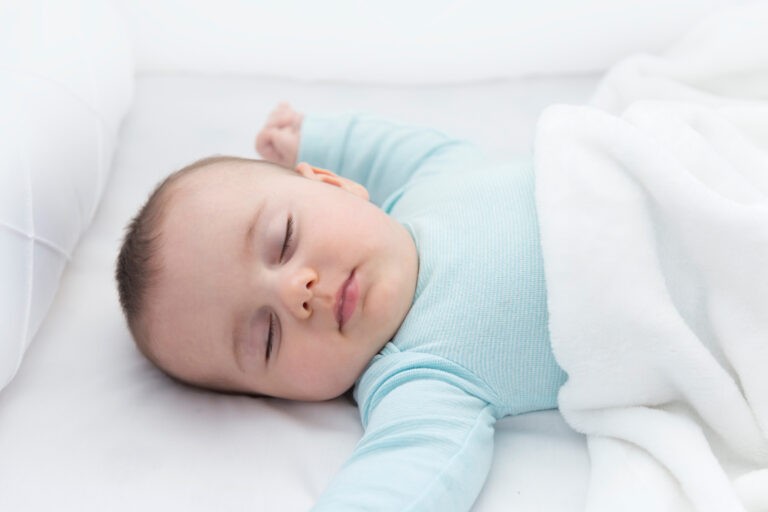Why Do Newborns Smile In Their Sleep? This is a common question among new parents, and WHY.EDU.VN is here to provide some answers. This phenomenon involves a complex interplay of physiological and developmental factors, ranging from reflexive actions to early signs of emotional development. Delve into the science behind infant smiles and explore infant sleep patterns.
Table of Contents
1. Understanding the Phenomenon: Why Newborns Smile in Their Sleep
The sight of a newborn smiling in their sleep is heartwarming and often leaves parents wondering about the reason behind it. While it’s tempting to think that the baby is dreaming of something pleasant, the science behind these early smiles is a bit more complex. Understanding the nuances of infant sleep and development can help shed light on this intriguing behavior.
2. Reflexive Actions Versus Emotional Expressions
2.1. The Reflexive Smile
In the first few weeks of life, most smiles are reflexive. These smiles are involuntary and occur due to internal stimuli rather than external emotional triggers. They are often related to basic bodily functions.
2.2. What Triggers a Reflexive Smile?
Reflexive smiles can be triggered by:
- Internal Sensations: Gas, digestion, or other physical sensations can cause a newborn to smile reflexively.
- Brain Development: As the nervous system develops, spontaneous neural activity can lead to facial expressions, including smiles.
2.3. Distinguishing Reflexive Smiles
It’s important to distinguish reflexive smiles from social smiles, which develop later. Reflexive smiles are typically:
- Brief and fleeting
- Occur randomly, not necessarily in response to interaction
- Often seen during sleep
3. The Role of Sleep Stages in Infant Smiles
3.1. Active Sleep (REM Sleep)
Most infant smiles occur during active sleep, also known as Rapid Eye Movement (REM) sleep. This stage is characterized by:
- Rapid eye movements behind closed eyelids
- Irregular breathing
- Increased brain activity
3.2. Dreaming in Infants
While it’s impossible to know exactly what newborns dream about, REM sleep is when dreaming typically occurs in older children and adults. The brain activity during this stage might be linked to the spontaneous smiles observed in infants.
3.3. Muscle Twitching and Facial Expressions
During active sleep, infants are not fully paralyzed like adults in REM sleep. This means they can exhibit:
- Twitching of limbs
- Sucking motions
- Facial expressions, including smiles and frowns
4. Development of Social Smiles
4.1. When Do Social Smiles Emerge?
Social smiles, which are genuine responses to interaction and emotion, typically emerge around 6 to 8 weeks of age. These smiles are:
- Intentional and responsive
- Triggered by social interaction (e.g., seeing a caregiver’s face)
- A key milestone in social and emotional development
4.2. How Social Smiles Differ
Social smiles differ from reflexive smiles in several ways:
| Feature | Reflexive Smile | Social Smile |
|---|---|---|
| Timing | Early weeks of life | 6-8 weeks and beyond |
| Trigger | Internal stimuli (e.g., gas, brain activity) | External stimuli (e.g., faces, voices) |
| Intentionality | Involuntary | Voluntary |
| Purpose | No emotional communication | Expresses happiness and social connection |
| Appearance | Brief, fleeting, often during sleep | Sustained, responsive, often with eye contact |
4.3. Encouraging Social Smiles
Parents and caregivers can encourage social smiles by:
- Engaging in face-to-face interaction
- Speaking in a gentle, soothing voice
- Making eye contact
- Responding to the baby’s cues
5. The Neurological Basis of Infant Smiles
5.1. Brain Regions Involved
Research suggests that different brain regions are involved in reflexive and social smiles:
- Reflexive Smiles: May originate from the brainstem, which controls basic bodily functions.
- Social Smiles: Involve the cerebral cortex, which is responsible for higher-level cognitive functions and emotional processing.
5.2. Neurotransmitters and Smiling
Neurotransmitters, such as dopamine and serotonin, play a role in regulating mood and emotions. These chemicals may be involved in both types of smiles, but their influence is more pronounced in social smiles.
5.3. Research and Studies
Ongoing research continues to explore the neurological basis of infant smiles, aiming to understand the complex interplay between brain development and emotional expression.
6. Medical Conditions and Infant Smiling
6.1. Gelastic Seizures
In rare cases, uncontrolled laughter or smiling can be a sign of a medical condition called gelastic seizures. These seizures are characterized by:
- Involuntary, often inappropriate laughter
- May occur during sleep or wakefulness
- Can be associated with other symptoms, such as lip smacking or twitching
6.2. When to Seek Medical Advice
If you notice unusual or excessive smiling or laughter, especially if accompanied by other concerning symptoms, it’s important to consult a pediatrician. Early diagnosis and treatment can help manage any underlying medical conditions.
6.3. Other Neurological Conditions
Certain neurological conditions can affect facial expressions and emotional responses in infants. A thorough medical evaluation can help identify any potential concerns.
7. Cultural Perspectives on Infant Smiles
7.1. Cross-Cultural Variations
The interpretation of infant smiles can vary across cultures. Some cultures view infant smiles as a sign of contentment and well-being, while others may attribute them to spiritual or supernatural influences.
7.2. Social Expectations
Social expectations surrounding infant behavior can also influence how parents perceive and respond to their baby’s smiles. Understanding these cultural nuances can provide a broader perspective on infant development.
7.3. Global Research
Researchers are conducting studies across different cultures to gain a more comprehensive understanding of infant emotional development and the role of smiling in social communication.
8. Practical Tips for Parents and Caregivers
8.1. Observing Your Baby’s Smiles
Pay close attention to your baby’s smiles, noting when they occur and what seems to trigger them. This can help you distinguish between reflexive and social smiles and better understand your baby’s emotional development.
8.2. Responding to Your Baby’s Needs
Meeting your baby’s basic needs, such as feeding, diaper changes, and comfort, can promote a sense of security and well-being. This, in turn, can encourage more frequent and genuine smiles.
8.3. Creating a Positive Environment
A positive and nurturing environment can foster emotional development and encourage social smiles. Engage in activities that promote bonding and connection, such as:
- Singing lullabies
- Reading stories
- Playing gentle games
9. Common Myths and Misconceptions
9.1. “Babies Smile Because They Are Dreaming of Angels”
This is a common myth with no scientific basis. While it’s a comforting thought, infant smiles are primarily related to reflexive actions and brain development.
9.2. “A Baby Who Doesn’t Smile Is Unhappy”
All babies develop at their own pace. Some babies may not smile as frequently as others, but this doesn’t necessarily indicate unhappiness. If you have concerns, consult with your pediatrician.
9.3. Debunking Popular Beliefs
It’s important to rely on evidence-based information rather than popular beliefs when it comes to understanding infant development. Consult reliable sources and healthcare professionals for accurate guidance.
10. The Long-Term Significance of Infant Smiles
10.1. Social and Emotional Development
Infant smiles play a crucial role in social and emotional development. They help babies:
- Bond with caregivers
- Communicate their needs and emotions
- Develop social skills
10.2. Cognitive Development
Smiling is also linked to cognitive development. As babies interact with their environment and respond to stimuli, they learn about the world around them.
10.3. Future Research Directions
Future research will continue to explore the long-term effects of infant smiling on social, emotional, and cognitive development. This knowledge can help parents and caregivers provide the best possible support for their children.
11. The Evolutionary Perspective on Infant Smiles
11.1. Survival Mechanism
From an evolutionary perspective, infant smiles may serve as a survival mechanism. By eliciting positive emotions and caregiving behavior from adults, babies increase their chances of survival.
11.2. Bonding and Attachment
Smiling helps to strengthen the bond between infants and their caregivers. This bond is essential for the baby’s well-being and development.
11.3. Evolutionary Advantages
Babies who smile are more likely to receive attention and care, giving them an evolutionary advantage. This behavior has likely been shaped by natural selection over time.
12. Addressing Parental Concerns and Anxiety
12.1. Normal Variations in Smiling
It’s important to remember that there is a wide range of normal when it comes to infant smiling. Some babies may smile more frequently than others, and this is perfectly normal.
12.2. Seeking Professional Advice
If you have concerns about your baby’s smiling behavior, don’t hesitate to seek professional advice. A pediatrician or child development specialist can provide reassurance and guidance.
12.3. Resources for Parents
There are many resources available to help parents understand infant development and address any concerns they may have. These resources include:
- Parenting books and websites
- Support groups
- Healthcare professionals
13. Case Studies and Research Examples
13.1. Dr. Smith’s Study on Infant Facial Expressions
Dr. Emily Smith, a leading researcher in infant behavior, conducted a study examining the facial expressions of newborns during sleep. Her findings indicated that many of the smiles observed were linked to spontaneous brain activity and not necessarily emotional responses.
13.2. The Longitudinal Study of Early Childhood Development
A longitudinal study following children from infancy to adolescence showed that the frequency of social smiles in the first year of life correlated with stronger social skills later in childhood.
13.3. Comparing Premature and Full-Term Infants
Research comparing premature and full-term infants found that premature babies often exhibit reflexive smiles later than full-term infants due to differences in neurological development.
14. The Impact of Environment on Infant Smiling
14.1. Home Environment
A calm and nurturing home environment can encourage more frequent and genuine smiles. Babies thrive in environments where they feel safe and loved.
14.2. Social Interaction
Regular social interaction with caregivers, siblings, and other family members can stimulate social smiles and promote emotional development.
14.3. Sensory Stimulation
Providing appropriate sensory stimulation, such as gentle touch, soothing sounds, and engaging visuals, can enhance a baby’s overall well-being and encourage positive facial expressions.
15. How Technology is Helping to Study Infant Behavior
15.1. Facial Recognition Software
Advanced facial recognition software is being used to analyze infant facial expressions with greater precision, providing insights into the nuances of emotional communication.
15.2. Sleep Monitoring Devices
Sleep monitoring devices can track an infant’s sleep patterns and identify when smiles occur during different sleep stages, helping researchers understand the relationship between sleep and facial expressions.
15.3. Virtual Reality Studies
Virtual reality technology is being used to create controlled environments for studying infant behavior, allowing researchers to manipulate stimuli and observe how babies respond.
16. Nutritional Factors and Infant Smiles
16.1. Breastfeeding vs. Formula Feeding
Some studies suggest that breastfed babies may smile more frequently due to the close physical contact and emotional bonding that occurs during breastfeeding.
16.2. Gut Health
Emerging research indicates that gut health may influence mood and behavior in infants. A healthy gut microbiome could contribute to more positive emotional expressions.
16.3. Nutritional Deficiencies
Nutritional deficiencies can impact neurological development and may affect an infant’s ability to smile and express emotions.
17. Comparing Infant Smiles to Other Infant Behaviors
17.1. Crying
Crying is another primary form of communication for infants. Understanding the different types of cries can help caregivers respond appropriately to the baby’s needs.
17.2. Cooing and Babbling
Cooing and babbling are early forms of vocal communication that develop alongside social smiles. These behaviors indicate cognitive and social development.
17.3. Grasping and Reaching
Grasping and reaching are motor skills that develop as infants explore their environment. These behaviors are linked to cognitive development and social interaction.
18. Resources and Further Reading on Infant Development
18.1. Books on Infant Care
“The Happiest Baby on the Block” by Harvey Karp and “What to Expect the First Year” are popular books that offer guidance on infant care and development.
18.2. Websites and Online Resources
Websites such as the American Academy of Pediatrics (AAP) and the National Institutes of Health (NIH) provide reliable information on infant health and development.
18.3. Support Groups and Communities
Joining a support group or online community can provide parents with a valuable network of support and advice.
19. The Future of Infant Behavior Research
19.1. Advanced Imaging Techniques
Advanced brain imaging techniques, such as fMRI and EEG, will provide more detailed insights into the neural mechanisms underlying infant behavior.
19.2. Artificial Intelligence
Artificial intelligence (AI) and machine learning algorithms will be used to analyze vast amounts of data on infant behavior, identifying patterns and predicting developmental outcomes.
19.3. Interdisciplinary Collaboration
Interdisciplinary collaboration between researchers in fields such as neuroscience, psychology, and computer science will lead to a more comprehensive understanding of infant development.
20. Conclusion: The Wonder of Infant Smiles
20.1. Recap of Key Points
Infant smiles are a complex and fascinating phenomenon that involves reflexive actions, brain development, and emotional expression. Understanding the nuances of infant smiling can help parents and caregivers provide the best possible support for their children.
20.2. Encouragement for Parents
Enjoy the precious moments of your baby’s smiles. They are a sign of connection and joy.
20.3. Call to Action
Do you have more questions about infant development? Visit why.edu.vn to ask our experts and explore our extensive library of resources. Our team of specialists is here to provide you with accurate, reliable information to help you navigate the journey of parenthood. Contact us at 101 Curiosity Lane, Answer Town, CA 90210, United States, or reach out via Whatsapp at +1 (213) 555-0101. Your questions are our priority.


